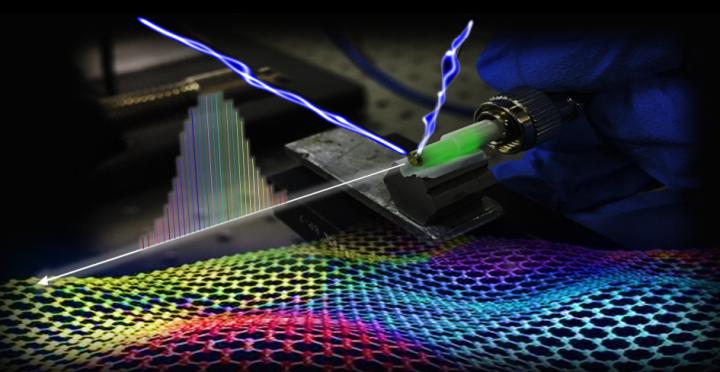
Credit: by Chenye Qin, Kunpeng Jia, Qianyuan Li, Teng Tan, Xiaohan Wang, Yanhong Guo, Shu-Wei Huang, Yuan Liu, Shining Zhu, Zhenda Xie, Yunjiang Rao, & Baicheng Yao
The development of laser frequency combs has revolutionized optical communication, photonic sensing, precision spectroscopy, and astronomical observation. Stable frequency combs could be achieved via mode locking in rare-earth doped fiber lasers, generating Kerr solitons in parametric oscillators, or opto-electrically modulating lithium niobate microresonators with strong second-order nonlinearity. For many out-of-lab applications, people desire a compact comb devices with multiple advances, such as all-in-fiber integration, low driven power but high efficiency, full stabilization, and diverse comb outputs with fast and convenient tunability.
In a recently published paper in Light: Science & Applications, scientists from the University of Electronic Science and Technology of China, Nanjing University, Hunan University and University of Colorado, Bouder, demonstrated a graphene heterogeneous fiber micro resonator. Leveraging the electrical tunability of the graphene semiconductor incorporated in a fiber F-P microcavity, they demonstrate dissipative soliton mode-locked laser combs generation, and the capability to control comb dynamics in situ. Taking advantage of the tunneling diode effect, the researchers realize a remarkable graphene Dirac Fermion tuning from 0 to 0.45 eV. This leads to modulation depth controllable in range of 0.1% to 1.4 %. In consequence, mode locked laser frequency combs with unprecedentedly dynamic tunability are demonstrated, in both fundamental and harmonic states. Moreover, the graphene integrated microlaser device provides a powerful way to opto-electrically stabilize the comb lines after 1/2 octave supercontinuum amplification, the phase noise reaches the instrument-limited floor of -130 dBc/Hz at 10 kHz offset, suggesting timing jitter less than 2.5×10-15 s per roundtrip. Such realization of the microcomb’s dynamic control and stabilization, in a graphene heterogeneous fiber microcavity, would provide a new platform at the interface of single atomic layer optoelectronics and ultrafast photonics, lighting versatile applications for arbitrary waveform generation, fiber communication, signal processing, and spectroscopic metrology.
###
Media Contact
Baicheng Yao
[email protected]
Related Journal Article
http://dx.




